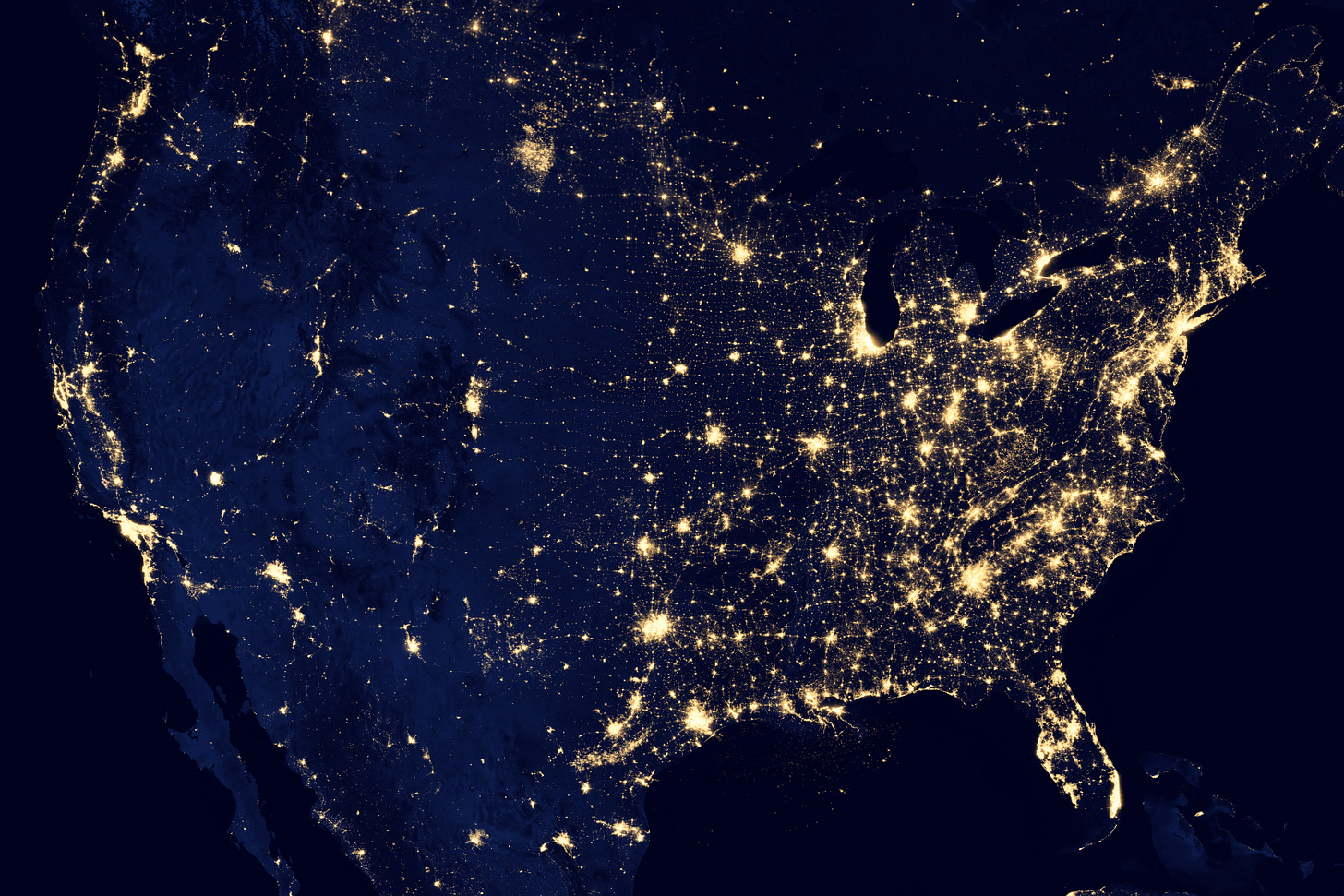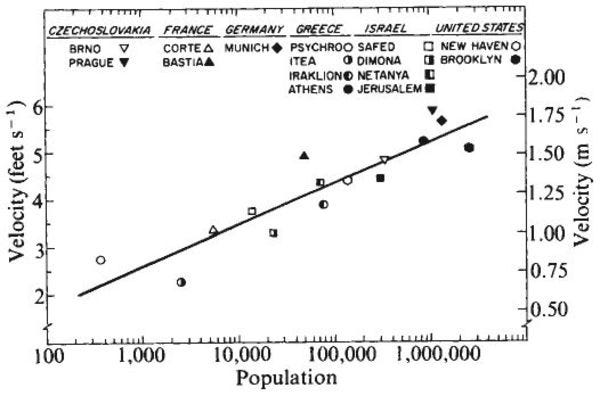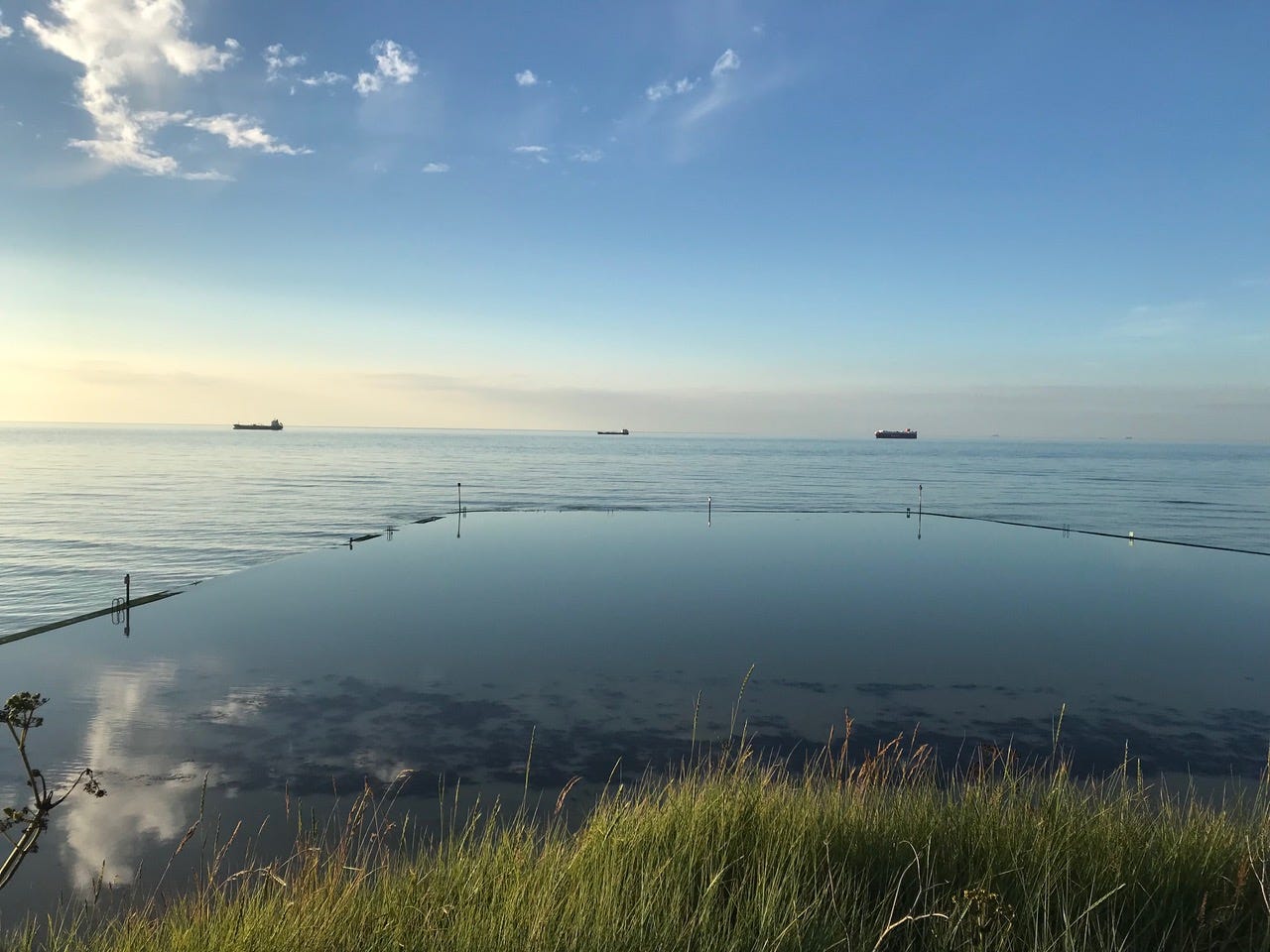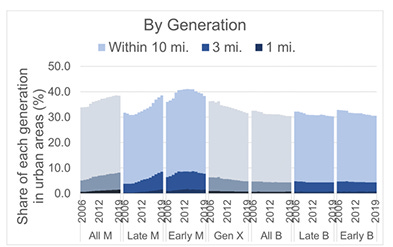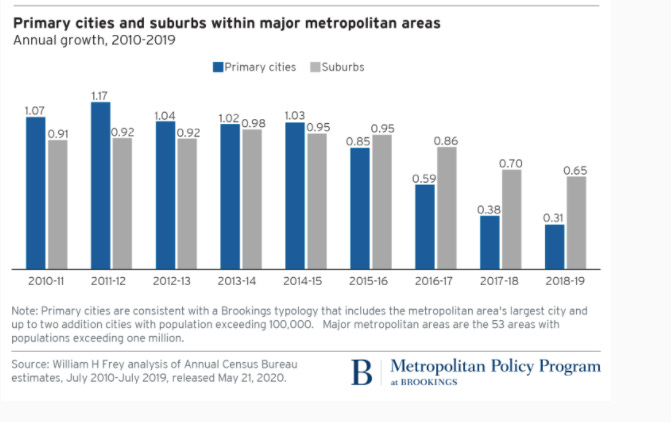Climate Solutions // I S S U E # 68 // City Quitters
Hothouse is original climate journalism with a way to act. As a climate solutions newsletter, we dig into the evidence, figure out what works, and deliver the news to your inbox. This issue is the first installment in a series about the climate impact of leaving cities. Subscribe here.
Look back at the great arc of human history, and you’ll find humans becoming an urban species. Until recently, only a tiny fraction of the world’s people lived in cities. Today, the UN estimates, more than 55% of us make our homes there (cities overtook rural areas in 2007). By 2050, that number is expected to reach 67%.
It’s easy to understand why. Cities call to us. As the birthplace of fortunes and culture, they draw in millions of people every year, and keep many until the end. They’re also just really exciting. Like nowhere else, cities let us throw ourselves into the mix, anonymously rub shoulders with millions of others, and free us to explore whatever humanity has to offer. As much as I love the wilderness, I’m a fan.
But cities change us too, often in ways we never realize. One of the most revealing was observed in the journal Nature in 1976. Scientists traveled around the world timing the walking speeds of inhabitants across 15 different cities from Psychro, Greece (population 365) to Brooklyn, New York (population 2.6 million). Across even vastly different cultures, the same pattern held: the bigger the city, the faster the residents walked. See the study’s chart below.
No one knows quite why. One theory is that it’s a social response to the sheer crush of people. Another, my favorite, is that it’s about money. Specifically, people move faster in bigger cities because time there is more “expensive.” In 1989, geographers D. Jim Walmsley and Gareth Lewis replicated the original experiment, obtaining similar results. Their reasoning was that “economizing on time becomes more urgent and life becomes more hurried and harried” as a city’s population, average wages, and cost of living all rise together.
If you don’t believe the science, consider the literature. Russian literature. Leo Tolstoy knew, well before Nature, that cities change people’s relationship with time and money. In his novel Anna Karenina, Tolstoy described how the nature of money seemed to transform, almost like the change from ice to water, as one moved from the country to the capital.
In the novel, Levin, one of Tolstoy’s most autobiographical characters, relocates to Moscow and soon realizes how profoundly his relationship with money has been upended. Whereas he once considered how much rye it would take to grow to earn a banknote, or how “twenty-eight roubles meant nine measures of oats, which men would with groans and sweat have reaped and bound and thrashed and winnowed and sifted and sown,” this all quickly faded.
“Now the notes he changed no longer aroused such reflections, and they flew off like little birds,” Levin recounts for himself. “Whether the labor devoted to obtaining the money corresponded to the pleasure given by what was bought with it, was a consideration he had long ago dismissed.… Only one thing was essential: to have money in the bank, without inquiring where it came from, so as to know that one had the wherewithal to buy meat for tomorrow.”
Now (if you’re still with me) you’re wondering: What could this possibly have to do with the climate? Well, you may have noticed during the pandemic a great reshuffling. People decided to move homes, cities, states, and even countries (👋). Many of us lost someone, or were stuck inside for weeks on end, reassessing what we wanted out of life.
For Rosie Spinks, this month’s Hothouse writer, that meant leaving London. Rosie, as you might know from her issue on how travel must evolve following the pandemic, was once a travel writer. Her life consisted of jetting to locations around the globe, living out of a packed suitcase, and grasping for that next brass ring. Not anymore.
In this month’s Hothouse issue, she’s writing about city quitters. People who have decided, for whatever reason, to leave behind the fast-paced sidewalks, and set out for dirt roads. Rosie, it turns out, is not alone, affecting everything from jobs to ambitions.
This month, we’ll explore how decamping from the city, individually and en masse, is having a climate impact, and what that might mean in your own life.
Thanks for joining Hothouse.
Mike Coren
Editor-in-chief
Here come the ‘city quitters’
By Rosie Spinks
I loved a lot about life in London. The sense of anonymity, the weighty feeling of history that hangs over everyday life, and the fact that you’re never too far from green space. I loved that walking for miles, with no set plan of where you were going, save for a well-hidden pub just off a canal, was a thoroughly entertaining (and free) way to spend a Sunday. I loved sitting on the top deck of a quiet bus—left side, third row—and feeling like you were at the center of the world somehow.
After just shy of a decade of living in London, I left. This was still early in the pandemic. I moved to a town of around 60,000 on the southeast coast of England for reasons that will be familiar to many: a lower cost of living, a slower life, a desire to work less, and less of a need to be in a densely-packed city to sustain my career thanks to the normalization of remote work.
I am part of a much-larger—and much-discussed—trend of people leaving urban areas spurred on by the pandemic. The exact numbers are a bit murky, but by some estimates, 13.5% more Americans moved from high-cost metro areas to either mid-sized cities or rural areas, small towns, and suburbs during the pandemic. More people are still making the same decision, as sky-rocketing home prices outside of the big metros suggests.
Living in cities, conventional wisdom asserts, is one of the least carbon and resource-intensive ways to live. You don’t need a car, you likely live in smaller square footage, and economies of scale help efficiently meet urbanites’ every need. According to one study, an urban dweller’s carbon footprint in Europe across categories that included food, private transport, and housing is 7% lower than a rural dweller’s footprint, all else equal. In the US, the number is bound to be far higher.
What are the climate impacts of this migration? Since leaving London for the Victorian-era tidal pools of Margate, England, I’m less and less convinced my way of life was inherently more sustainable. It wasn’t the carbon math that was wrong. It was the attitude that resulted from living such a fast-paced, linear life.
These days, my annual air miles have plummeted, I spend less money on things like convenience sushi for lunch, drinks after work that inevitably turn into dinner, and that lazy Uber ride home. I have less exposure to the kinds of shiny, new things—like those boots in the window that look much sharper than my three-year-old Dr. Martens—that cities offer at every turn. I work less, I have more time to participate in the local and buy-nothing economy where I live, I pay more attention to local environmental issues, and I even plant my own pollinator-attracting plants and volunteer in a community garden once a week.
In short, living in a place that is less obsessed with consumption, achievement, and ambition has made me less so, as well. It feels like a positive shift both for me and the climate. We could crunch the numbers and argue endlessly about which lifestyle results in fewer emissions, but perhaps that would be measuring the wrong things.
As I’ve settled into post-London life, I’ve begun to think it might be the better place to plan an uncertain future. Many of the habits that city life ingrained into me—fierce individualism, an addiction to instantly gratifying my every need, an expectation that my income would continue rising, and a propensity to always be looking around the corner for the next exciting trip or distraction—feel ill-suited for what faces us. I’ve begun to wonder if a larger shift is at play.
More and faster and better
It’s hard to argue with the hold that urban life has on the minds and lives of the ambitious, and upwardly mobile. The early 2010s saw an urban revival across cities in the US and Europe led by millennials who flocked to city centers. But by 2013, that growth had begun to slow or even reverse, reports Harvard University.
Now, more than two years into the pandemic, the trend is in retreat, especially among Gen Xers and older Millenials. Many cities with more than 1 million people saw their population growth rates fall between 2017 and 2021. Grow rates in the suburbs, says the Brookings Institute, are now outpacing their metros, a trend accelerated by the pandemic.
“People are asking deep questions about how and where they want to live,” says urban theorist Richard Florida. There is a sense that spending five to 10 years in an expensive city may no longer be an essential ingredient to building a promising future.
As writer Katherine Boyle notes in her Substack newsletter, “our culture has sold us a convenient lie that puts most young people at a grave disadvantage: to get a good job, one needs to go to an expensive college in a different state than where they grew up. After college, one needs to move to a big city for that job and crushing student debt makes it too expensive to save for a home.”
All of this is predicated on the idea that the young city-dweller’s income will steadily rise to make this all feasible. But just barely surviving in cities where the cost of living keeps sky-rocketing doesn’t allow people to think very far outside sustaining their own lifestyle or career, onto the enormous shared challenges we face. The impact of that can be seen everywhere from the individual—an episode or two of burnout is now seen as an all-but-standard milestone of a working professional’s life—to the social isolation and collective loss of civic life beyond what passes for conversation on Twitter.
More than anything else, the tenor of modern urban life is predicated on more and faster and better. Sure, you could argue that improving technology will eventually catch up with our appetites, that we’ll enjoy cheap, abundant clean energy in a low-waste society. But I’m not so convinced that technology will outrun capitalism’s imperative for more. Maybe we don’t need better technology, but rather altered expectations of what a satisfying life looks like.
A place for ‘sustainable creative practice’
There was something else at the core of my decision to move away from urban life. It was an urgent need to soothe my frayed nerves and take a cue from nature—the fact that life is not a linear pursuit, but a cyclical one. After a decade pursuing professional success as a journalist with single-minded zeal, I was left feeling disillusioned and empty. Above all, I knew I could not survive another cycle of burnout—one where I would overwork, feel my mental and physical health suffer, resolve to do better, cut back, only to start all over again when some tantalizing opportunity came my way.
“The desire for an alternative life away from urban constraints was bubbling away before the pandemic hit,” author and trend forecaster Karen Rosenkranz said in a 2021 TedTalk about her book, City Quitters (the inspiration for this article’s title), which focused on creative professionals and entrepreneurs who moved to rural areas with populations under 10,000. Her work examines the phenomenon of creative professionals and entrepreneurs leaving large cities for rural areas. She speaks of “the potential of the countryside as a place for sustainable creative practice,” a place where humans can more easily cultivate connections to nature, to people, and to self without the pressures of having to pay ever-increasing rents.
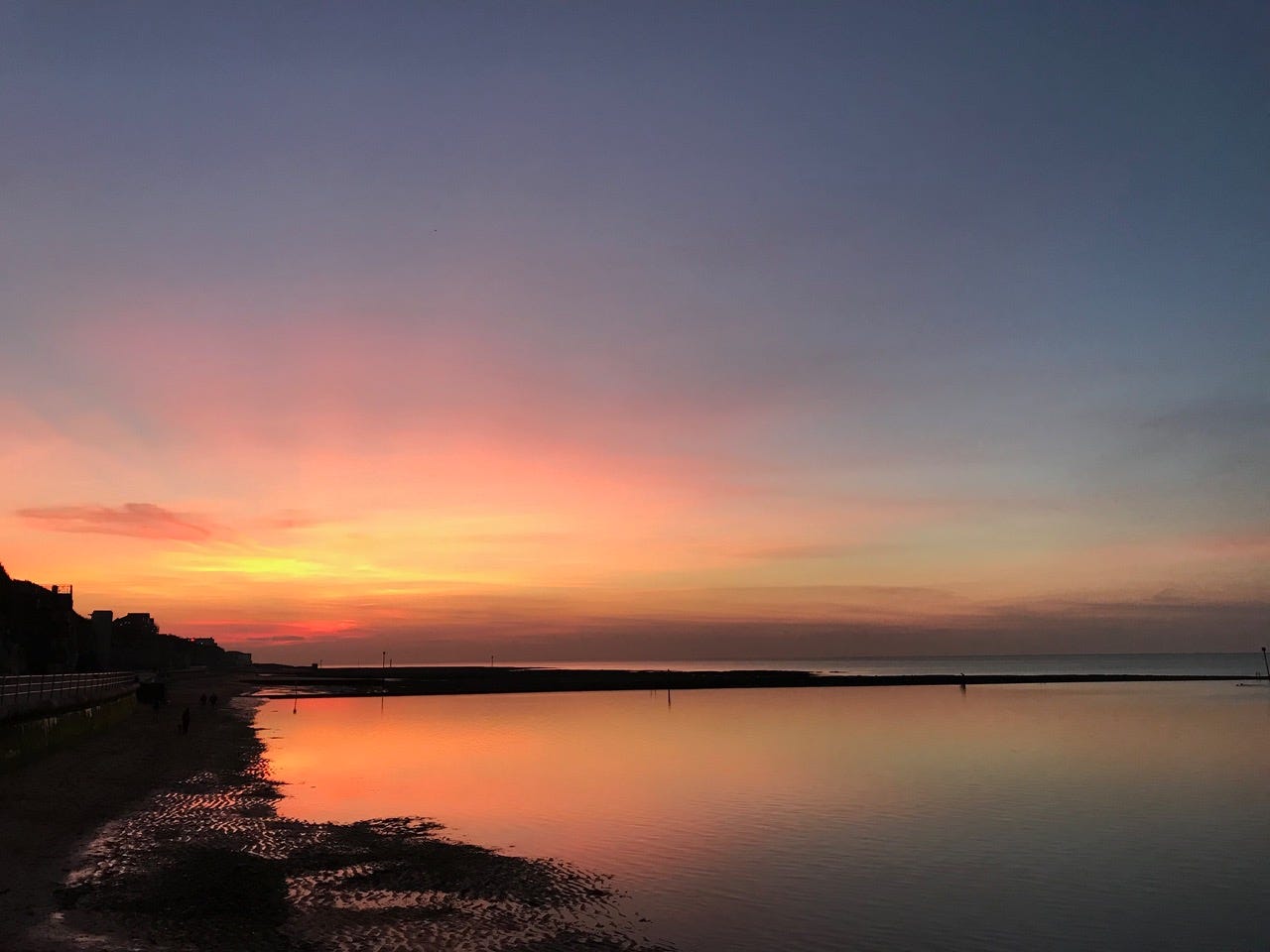
By sustainable, Rosenkranz told Hothouse she means “something that regenerates you enough so you can keep doing the work and it doesn’t crush you and burn you out.” This often leads to a more in-touch relationship with the natural world, Rosenkranz said, like screen-based knowledge workers who spend more time outdoors working in their vegetable garden during the summer, and hunkering down on ambitious work projects in the winter.
“Living with seasons is a lot more pronounced where you actually notice what kind of weather it is, and you let that impact you and your work and your pace,” Rosenkranz said, “because you go a bit slower you’re also a bit more conscious of your own needs, your own body’s rhythm.”
This kind of “sustainability” is one that’s often left out of the climate conversation: the sustainability of the pace of our lives. And there’s an important parallel there. The more I slowed down, the more I noticed the dynamics that drive unhealthy comparison, ambition, and ultimately burnout in urban life are the same ones that drive linear growth mindset, endless fossil fuel extraction, and the sometimes perverse logic of capitalism.
After all, the more burned out I was from working constantly, the more I needed the trips away for a weekend, the constant convenience food, the next day delivery, and the escapism to keep my life going. Meanwhile, I had virtually no bandwidth to really think deeply about the climate emergency, get involved in causes or projects that did not directly benefit my career or my life, or consider what my shiny professional resumé might be worth in our precarious future.
In short, the life I was building in a city—atomized, devoid of non-screen-based skills, dependent on airplanes and complex supply chains and infrastructure to meet my every need and desire—didn’t really make sense when I pitted it against the climate emergency we all face.
Not your parents’ suburbs
So are city quitters leading to a better climate future?
There’s admittedly some doubt about whether the great urban “exodus” during the pandemic justifies the word (overall migration levels actually fell during the pandemic in the US). Or it may merely be an intensification of the urban sprawl trend, swelling so-called satellite cities once deemed too far away from anything else to be desirable. These are places like Tempe, Arizona and Spokane, Washington, where “the outskirts of yesterday are the mainstream of today,” as one homebuilding executive put it to Bloomberg.
Of course, many do not have the luxury of mobility. Socio-economic status often underpins the ability to move someplace smaller; people of color, the LGBTQ community, and other minority groups often experience more discrimination and can find less solidarity in less populated areas.
Yet there’s a chance to redefine what has historically been meant by “moving to the suburbs.” Traditionally, that’s meant a move primarily to expand one’s own comfort and wealth, get a bigger yard, and maybe settle down and have kids—kids who will, one day, start the cycle all over again.
But thanks to Covid, there is a huge opening to build lives and careers without the massive economic cost of urban life. To change what an aspirational life looks like, to one that leaves us with more energy to focus on things outside of our own careers and families. Right now, city quitters have an imperative to, as Rosenkranz put it, “bring something new, add value to the place that they’re moving to, and be interested to connect to the community and what’s already there.”
Indeed that’s the crucial question: When we finally do slow down, when we’re no longer working so hard to pay the rent, what do we do with all that extra free time, income, and headspace? That’s where the potential of city quitting is most exciting. The hardened city cynic in you may think it all sounds too good to be true. But in fact, it’s much more in line with how we’re designed to live.
Next week, we’ll take a closer look at the externalities that city quitting has, from real estate and transportation to utilities and local economies. Plus, we’ll consider whether moving away from population centers can, counterintuitively, make us more connected to each other.
See you then.
Correction: This story was updated to note that medium-sized cities saw a decline in population growth rates, not total population.
Rosie Spinks is a freelance writer based in Margate, England. She is the author of What Do We Do Now That We’re Here, a newsletter that examines how to live a meaningful life in a chaotic, unstable world. You can find her online @rojospinks.
Hothouse is a weekly climate action newsletter written and edited by Mike Coren and Cadence Bambenek. We rely on readers to support us, and everything we publish is free to read. Follow us on Twitter or LinkedIn.






